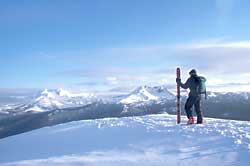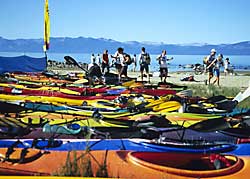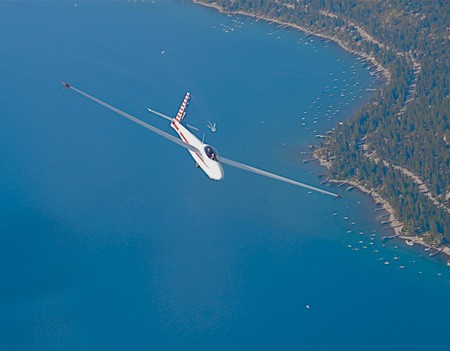- Free Climber: Lynn Hill
- Mind over Suffering: Mark Allen
- The Great Stuntman: Warren Miller
- Golbal Warmer: Jack O ’Neill
- Singletrack Mind:Keith Bontrager
Fifty years ago, the world was a harsher, more primitive place—at least in terms of adventure sports. Think for a moment about a little route on El Capitan in Yosemite called The Nose. Its slick granite face was difficult for a team of climbers to ascend after weeks of dangerous toil, let alone all-free and in a day. Meanwhile, bicycles of the time didn’t boast suspension forks or disc brakes and surfers couldn’t stay in Northern California waters for longer than a half hour without turning blue. Skiing was still a ballet-like sport best done in stretchy woolens and leather boots, and no one even considered running a marathon, swimming 2.4 miles, and biking 112 miles consecutively while wearing a Speedo.
In the early 1990s, a young female climber who had recently recovered from a 75-foot fall managed to free-climb The Nose in a day. It was a feat that astounded and inspired the climbing world. Now there are numerous all-free routes on El Cap, but no one else has managed to free the Nose in a day.
Bicycles before the 1980s were not meant for riding in the dirt. They were often long on style but short on ease of use. But following in the footsteps of the Mt. Tam posse of riders like Gary Fisher and Joe Breeze, Keith Bontrager managed to help stage a revolution in the world of mountain biking with component and frame design. Let’s just say that this year’s Tour de France winner had a little help, at least in the bike department, from Bontrager.
Just as Bontrager helped to define mountain biking with his innovative designs, Jack O’Neill changed the lineup in the water. It is hard to imagine life before the wetsuit, but apparently it was tolerable-—for
about 30 minutes. Experimenting with all sorts of materials, O’Neill finally struck black gold when he started stitching together panels of neoprene, thus creating the wetsuit and fostering the surfer way of life.
Warren Miller, one of the original ski bums, brought his lifestyle to the big screen. During his 55 years as the reigning king of the ski flick, Miller, with his signature witticisms and enthusiasm, caught the evolution of extreme on tape. When he first started filming, skiers could catch just a few feet of air on their wooden sticks. Now they can out-ski avalanches.
And for those who find enlightenment within suffering, Mark Allen led the pack during six Ironman victories. Known for being the toughest one day event in the world, the Ironman exacts 140 miles of non-stop anguish from its participants. In 1995, he became the oldest victor at 37 years old, setting the stage for many “older” athletes to prevail in endurance sports for years to come.
What these athletes all have in common is that they have become living legends. In part due to their accomplishments, the world of outdoor sports has changed completely. In this issue, we discover what led them to their legendary status and why their accomplishments will never be forgotten.
—Christa Fraser
FREE CLIMBER: Lynn Hill
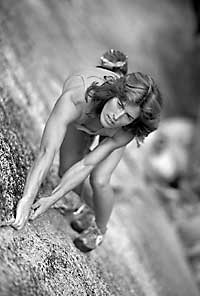
It is probably an exaggeration to call Lynn Hill the greatest living climber, but just barely. Certainly Lynn changed the sport of rock climbing forever, and arguably left a larger impression on the sport than any climber, man or woman, since or before the decade that she dominated the sport. Lynn often made her climbing accomplishments look easy, but as she reveals in her autobiography Climbing Free, her path to greatness was a perilous one.
“Where were you the day Lynn fell?” May 9, 1989 is a day that all longtime climbers remember vividly—the day that Lynn forgot to tie her knot and fell 75 feet to the ground from a cliff in France. At the time, Lynn was just about ready to make a powerful statement—that she, not Catherine Destievelle or any other European woman—was the strongest female climber in the world. The first international sport climbing competition was just a few weeks away in Leeds, England, and Lynn, the first woman to ascend the mythic grade of 5.14a, was all set to take the crown.
Instead, Lynn leaned back at the edge of the cliff, and the untied knot slipped through her harness. Wind-milling her arms in a vain attempt to keep from falling backwards off the cliff, the horror of what was about to happen became apparent. In her book, Lynn describes the survival process that unfolded as she purposely aimed her fall towards a small tree at the base of the cliff. The blood-curdling scream that left her lungs as she fell froze every climber at the cliffs that day, and dozens of horror-stricken people caught sight of a human figure hurtling through the sky. Falling the distance of a seven-story building, Lynn describes the event in her book:
“It is not true that in a fall one sees one’s life flash through one’s eyes. There is not enough time for even a single formed thought. But survival instincts are wired on a faster pathway than any other mental process, and when I saw the approaching tree I knew instinctively that my best chance to live was to land in it. Speeding toward it, I tucked my body into a ball, blasted through its branches, and then my left buttock slammed into a lattice of tree roots and everything went black.”
Later, Lynn awoke in a French hospital, broken but alive. Looking in the mirror was difficult—her face was black and blue and completely swollen. She describes those first few days in the hospital:
“Disappointment overwhelmed me. I staggered away from the mirror and its ugly reflection. Limping back to bed, I lay down. How well things had been going until this blunder. I felt I had a good shot at winning the
competition in Leeds and I was climbing harder than any woman ever had. Now my elbow may never heal well enough to climb at that level again. My life as a competition climber could be over. I am not the type given to crying,
but my eyes grew wet as I realized what I had always known—that nothing in life is guaranteed.”
Lynn Hill did bounce back from her climbing accident, and she came through the experience tougher and with more resolve. She went on to dominate competition climbing in Europe and America for a decade, often competing against the strongest men in the world. The fact that she is just over five feet tall is truly remarkable in a sport that often favors height.
When Lynn decided to retire from competition climbing in the early nineties, she was already the most famous rock climber in the world. However, her climbing career was not over.
In 1993, Lynn returned to her roots in Yosemite to free climb the Nose route on El Capitan. Unlike many of the European climbers she had competed against for so many years, Lynn had served a traditional apprenticeship. She had learned to climb in the ‘70s and was skilled in bold, runout lead-climbing. In traditional climbing, the free climber must set his or her own running anchors during upward progress, requiring judgment and experience
that bolt-clipping sport climbers don’t need. Aided by her background, Lynn would make a statement in a type of climbing far removed from plastic holds and indoor sport climbing competitions. Traditional adventure climbing was a world with very few female voices. By attempting to free climb the Nose, Lynn would be taking on a challenge that many of the top men in the sport had dreamed about for years.
When Warren Harding, Wayne Merry, and George Whitmore first climbed the Nose in 1958, success came after many months of effort, and vast stretches of aid climbing—essentially pounding in spikes to support rickety ladders that made the ascent possible. As revolutionary as it was at the time, Harding’s ascent was more of an engineering feat than anything else. What Lynn proposed to do was a gymnastic challenge that was almost shockingly ambitious: to use her fingers and toes to physically climb every inch of the route, using her ropes and gear as a safety net only. Anyone who has been to Yosemite and seen El Capitan has some understanding of Lynn’s ambitious project. Most tourists and climbers who see the Nose for the first time are dumbstruck. The Nose is so huge (over 3000 feet tall) it’s almost frightening to look at.
Lynn spent weeks rehearsing various sections of the Nose that had thwarted all previous free climbing aspirants. Finally she linked all the sections and was ready to return for a single free-climbing push from the ground.
When Lynn freed the Nose in less than 24 hours, her achievement stunned the climbing community. When the climbing press carried the story in early 1994 she was no longer just the best female climber, but possibly the world’s best climber, period. A decade later, no one else has completely freed the Nose in a day. ASJ recently spoke to Lynn about her accomplishments. When asked why she thought her free of the Nose in a day has never been repeated, she said:
“I can’t tell you exactly why. The most important thing is to have the vision and ability to link long stretches of highly tenuous climbing over 2000 feet off the ground. Tommy Caldwell is one name that
comes to mind in terms of someone who has the right background to pull it off. Some have said that I was able to free climb the Nose because of my small body size and small fingers, which gave me a unique advantage [the Nose has many thin cracks and pin scars], but I don’t buy that. The Nose will be freed in a day again, by the next person who comes along with the right desire, vision, and background.”
Lynn is not someone who likes to be put on a pedestal, and most likely will not like being called a ‘legend’ for the purposes of this article, but it is fair to say her climbing accomplishments are legendary. At the very least, Lynn Hill is an inspiration, and for this she is much admired.
—Matt
Niswonger
Mind
over Suffering: Mark Allen
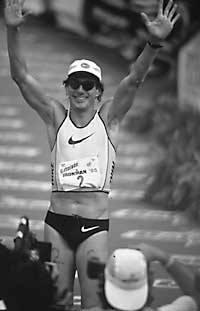
Growing up in Palo Alto in the ‘70s, there was little to suggest that Mark Allen would rise to become the most dominant athlete in the most demanding of sports. Of course, triathlons at the time were not on the radar screens of America’s youth, or just about anyone else for that matter.
“Athletically, I grew up as a competitive swimmer. But my results were outstandingly mediocre,” says Allen, now 46 and eight years into retirement. “I never qualified for anything big like Olympic trials
or national championships. So there was definitely a severe lack of foreshadowing that I would be able to do anything that one would consider better than middle of the pack in any other sport.”
So much for not standing out from the pack.
After years of disappointing collapses, Allen won the Hawaii Ironman six times, the toughest one-day sporting event in the world. His first victory came
in 1989 in an epic duel with six-time winner Dave Scott, and his last in 1995 at age 37, making him the oldest champion ever. Allen also excelled at short-course races, went undefeated in 10 trips to the Nice International Championships, and put together a winning streak of 20 races. He was named Triathlete of the Year six times and in 1997 Outside magazine pronounced him “The World’s Fittest Man.”
Before emerging from the pack, Allen went to college at UC San Diego, which he had chosen for its proximity to the waves, for he had been infected by the surfing bug while learning at the Hook in Santa Cruz. At UCSD, he lived right above Blacks Beach. He swam on the swim team. He worked as a lifeguard. Life was pretty ideal, if not particularly challenging.
In 1982, he tuned in to watch the Ironman and witnessed one of the most gripping scenes in sports history. After a 2.4 mile swim, 112-mile bike ride, and 26 miles of running, Julie Moss, a 22-year-old San Diego native, was in first place. A mere 400 yards the finish line, she fell and rose to her feet three times. Twenty feet from victory, she collapsed a final time and was passed. She crawled across the finish line to finish second, 29 seconds later.
For Allen, the moment was serendipitous in more ways than one. It inspired him to take up the sport, and seven years later, he and Moss would get married and have a son, Mats, now 10, together.
Unlike in the pool, Allen immediately distinguished himself as a triathlete. In his first race, he finished fourth behind the Great Scotts: Dave Scott, Scott Molina and Scott Tinley.
“When I started in triathlons right away things were different … As a swimmer, if someone got even a half a stroke lead on me my race was done. However, from my very first triathlon in 1982 I tried to see this sort of scenario from a different perspective. If someone did start to pull away from me, I just tried to relax and not worry about it, telling myself that something might change and that the person might come back to me if I just focused on racing as fast as I could … This turned out to be huge later in my racing in Kona where I always came from behind, especially in my final race in 1995 having to come back from a 13:30 deficit on the bike.”
Over the years, Allen’s reputation for mental toughness was often described as a “Zen-like focus.” More accurately, his mental strength was derived in part from the Shaman teachings of the Huichol Indians of central Mexico, a small tribe which has no history of war and accentuates celebrations of life. It was his connection with Shamanism that he credits with helping to kick off his wins in Hawaii.
“The ‘Zen-focus’ was something the media dreamed up to describe the way I tried to approach my races. Basically, I went to them to get a job done. I was not there to be anyone’s friend or to win
the most popular personality contest. I was aware of how much energy could leak out before an event by interacting too much with others. And I knew I didn’t have the genetics to rely on if my tank was not completely
full at the start of a very long day. So I tried to just stick to myself … to hold onto all the energy I had stored up prior to the race and then use it at the right moments in the event.”
“This all became easier to do once I started studying Huichol Shamanism with Brant Secunda. He helped me to be able to just approach everything with more of a calm steadiness, which is something the Huichols
value in life. He always emphasized that if we let ourselves get too up then we are also vulnerable to being really down. And I saw this play out over and over in races. Some athletes would be totally psyched up going into an
important event, but then at the first moment when things started going in the wrong direction their whole demeanor changed and they started to lose their positive focus.”
While Allen was nearly unbeatable at most races, before the ’89 Ironman he seemed to be eternally vexed by the ghosts of Kona, year after year falling victim to one thing or another, from a broken derailleur to internal bleeding. Six times he had finished in the top five, but when it came to winning, he was saturated with self doubt. And physically after six to eight hours of racing he seemed to fall apart. In both 1984 and 1987, Allen was leading on the run when he was passed in the lava fields by Dave Scott.
In early 1989, Allen tried to remedy this on a six-week training trip to New Zealand with several other top athletes. Without any distractions, “we put in some unbelievably monstrous training days and after six to eight hours I still felt strong. To my surprise, I could absorb it. It opened my eyes as to what was possible physically.”
Psychologically, though, Allen still felt shaky. “Somehow Kona finds where you’re weak,” he says. “There were plenty of things about it that intimidated me. In ’89, I knew I needed to overcome that.”
Allen shadowed Dave Scott throughout the race. “I swam right on Dave’s feet, we stayed together on the bike, and we ran together … Our splits were way under world-record pace.” Scott threw in some surges to try to break away. Allen, who was suffering from painful blisters that had formed and popped in his Nikes, was at first overcome by doubts. “Suddenly my mind went completely blank and all my negative thoughts left.” The image of Don Jose, a renowned 110-year-old Huichol shaman, whose face conveyed peace and power, lodged in his mind and he felt a surge of energy. At the last water station, Allen turned the tables on Scott and broke away for his first Ironman victory, winning by 58 seconds, blood seeping through his shoes.
“Before ‘89 had always gone to Hawaii wanting to win, thinking that would make my life complete … Now I realized it was better to go in feeling content. I was going about it backwards.”
Having long since conquered the demons of Kona, today Allen lives blocks from Pleasure Point, the spot where he learned to surf as a kid. He has his own online training website, MarkAllenOnline, in which he spills the knowledge from his 15 years at the top of the fitness pyramid. He also does occasional teaching clinics and TV commentary.
He is passionate about his work with Secunda and the Dance of the Deer Foundation Center for Shamanic Studies, based in Soquel. They developed a workshop, “Fit Body, Fit Soul,” and are finishing a book by the same title, aimed at athletes who have their bodies finely tuned but are missing something else and at spiritually oriented folks who know little about fitness and nutrition.
If triathlons hadn’t come about, Allen says he probably would have focused mostly on surfing. “It is a sport I do for pure exercising enjoyment. I don’t think I would have picked up running or cycling as a way to keep fit. But it is really hard to say now. In terms of a career, I probably would have ended up in some form of healing profession. Which form it would have taken I am not sure, but it definitely would have been something other than a Western approach to health and healing.”
—By Pete Gauvin
The Great Stuntman: Warren Miller
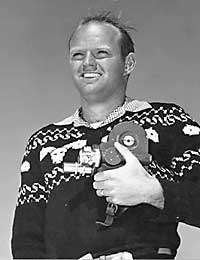
Warren Miller was born in 1924 in Hollywood, California during the era of silent films. Among the great silent films of that year was one by the comedic actor Buster Keaton called Sherlock Jr. In it, a young man works at a theatre manning the projector. Daydreaming, he slips into the world of the reel that he is playing and soon his life is dictated by the story of the film. Keaton was a consummate stunt man and often choreographed and then performed most of the stunts in his own movies.
It seems fitting then that Warren blazed the trails to make some of the best and most beloved of ski films in which he has choreographed unbelievable stunts and mixed in a bit of his own life and humor. He started making his films in 1949, and for the last 55 years, they have traced the arc of both cinematography and snow sports and pioneered many filming techniques.
1924 was also the year that the first Winter Olympics were held. Fittingly, they were held in Chamonix, France, a location that he would visit to film many times during his career. It hardly seems possible for him to have been born in a better year.
Though he was born at a pivotal time in the world of film and winter sports, he hardly enjoyed an easy childhood. The depression arrived when he was still a kid, but fortunately, he was able to buy his first camera during that time and begin his lifetime pursuit documenting “his own quest of freedom,” as he describes it. Warren also pursued a number of other interests, like the military, surfing, drawing and self-publishing books of his cartoons. (His book Wine, Women, Warren and Skis is currently in its 15th edition.)
But the winters of 1946 and 1947 changed everything for him. It was also a very important time for skiing for two reasons. The first was that the ski lift began to see public use in Aspen, Colorado and in Europe. It was also the year that P-Tex,a dense abrasion resistant plastic, was developed. P-Tex would become one of the primary components for making modern, light and durable skis. 1946 was also the most profitable year ever at that time for Hollywood films. Coincidentally, it was the year that Warren and Ward Baker spent traveling to ski resorts throughout the west.
Arguably, Warren and Ward ushered in the lifestyle of the ski bum when they spent the next couple of years traveling to different ski resorts, teaching ski lessons and living out of their trailer in various parking lots.
In 1949, after negotiating the loan of a movie camera and a small filming budget, Warren made his first ski film, which was called Deep and Light, probably a reference to the way he best likes his snow. The movie was made for a few hundred dollars.
He had essentially hit a gold mine. The rising interest in skiing, which was no longer just for the wealthy, combined with the rising numbers of moviegoers created a niche that he was only too ready to fill. Originally, Warren himself attended his film screenings and delivered a running commentary to the audience. But by the end of the ‘50s, his films were too popular for him to attend every screening, so he began to record his signature comments and narration right onto the film. Even without being there in person, he still managed to create an air of intimacy in his films, like a grandfather or uncle telling you a great story.
The difference between Warren and a lot of grandfathers and uncles, though, is that he tells a much hipper tale. He recently turned 80 years old, but has stayed current in the world of snow sports. As a result, his films have appealed to generation after generation of skiers and snowboarders. In fact, the soundtracks of his films feature a lot of great popular and underground music. Each film has become a time capsule of the culture of skiing in that year.
In 1954, he filmed what may be the first extreme move caught on film–the legendary Stein Erickson doing a front flip. Since that time, he has filmed Glen Plake popcorning down mogul fields, Olympic champion Johnny Moseley skiing Wiegele’s Alaskan territory, as well as Bode Miller, Barret Christy and Terje Haakonsen, among many, many others. In essence, Warren has caught 55 years of the evolution of skiing and snowboarding on film. But jack-of-all trades that he is he has also filmed skydiving, BASE Jumping, and kayaking.
He may or may not be retiring from making his films in the next year or so. He sold the company to his oldest son, Kurt, in the late eighties and has since moved to San Juan Island, Washington. “Right now we’re
negotiating for the next film,” he explains.
Somehow, though, the thought of a film with Warren’s name on it, but without his voice just doesn’t seem right. It would be akin to watching a silent Keaton film where he suddenly starts speaking to the audience, or where he is completely absent. What made a Keaton film was Keaton himself.
This is another important year for Warren. In the midst of completing a 22,000 square foot skateboarding park, he just celebrated his 80th birthday with a surprise party hosted by his family and friends. On his web page,
www.warrenmiller.net, he wrote this about the party: “I still find it hard to believe that the whole thing was to celebrate my 80th birthday. The joke is on everyone else because it was really just the 66th anniversary of my 14th birthday and I’m really only a 14-year-old kid trapped in a senior citizen’s body.”
—Christa Fraser
Golbal Warmer: Jack O ’Neill
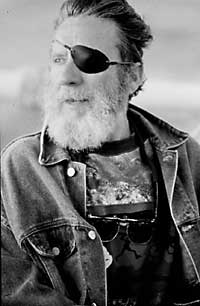
Jack O’Neill never figured out what hit him in the eye back in 1971 while surfing out front of his Pleasure Point home. Whatever it was caused him to go blind in his left eye. Over the years, the eye patch he donned to cover it up has become part of his iconic pirate-like image. He completes
the part with a full beard, tussled hair and a mischievous twinkle in his right eye. The eye patch, however inadvertent at first, now seems like such a natural fit, for in many ways his life path has been that of a wayfarer
of the sea.
Even with losing his eyesight, O’Neill never lost his vision. He has seen many waves and is pleased with the life he’s created directly and indirectly from their energy. “The ocean belongs to all of us. I’ve gotten so much from the ocean,” he smiles, his features softening.
Indeed he has, but he’s never taken this good fortune for granted.
From his creation of the first wetsuit back in 1952 in order to surf the chilly Northern California waters to his development of a company that would become one of the largest and most recognized brands in the industry, O’Neill has long been a living legend in surf circles and in local ocean lore.
He desires to instill in future generations the respect and wonder for the ocean he has. His Sea Odyssey program, started in 1997, offers young students free ocean education tours. The Sea Odyssey catamaran sails out of Santa Cruz harbor and teaches young generations about the ocean and sea life of the Monterey Bay National Marine Sanctuary.
“The Sea Odyssey is a way of putting things back. Once kids learn about the sea they never forget and want to give back to the ocean,” says O’Neill, now 81.
The view of the ocean from O’Neill’s cliff-side home in Santa Cruz is so close it’s like living on a boat. On big swell days, O’Neill must batten the hatches (literally, since downstairs windows are actually portholes) to prevent waves from crashing onto his bed. Being a Pisces, it’s easy to see that Jack O’Neill is a man who can’t live far from the sea and its salty air.
Ironically, O’Neill was born well inland, in Denver in 1923. Jack made his way to the coast early in life and spent his youth in Southern California. There he began his passion for the ocean by body surfing in the waves. Not content with exploring just the sea, Jack decided to take to the skies, as well. He enlisted in the Navy for World War II, where he learned to fly Waco 220-hp biplanes. After the war, he bought a Stearman biplane
and went into business for himself doing aerial advertising. But business was slow, so Jack decided to return to the sea and earn his living by commercial fishing off the San Francisco coast. That venture led to other jobs as varied as selling skylights and fire extinguishers.
San Francisco never has been known for its welcoming beaches. The dense coastal fog alone can chill to the bone, not to mention the fact that the average water temperature year round is a meager 52 degrees. Ocean
Beach, in particular, is known for its life-threatening currents, caused in part by the enormous tidal drain of San Francisco Bay. These notorious currents were deemed dangerous enough that there was a law against swimming in effect during the 1950s when O’Neill lived there. Step into the water and a horse-mounted policeman would come down to order you out.
Luckily, one cop decided to allow swimming and surfing at a single spot along the beach, Kelly’s Cove at the north end. That’s where Jack would return time and again to the purity of the ocean amidst the industry of a city. “If I got all screwed up being in downtown San Francisco working, I’d get into the water at the beach, catch that one wave and everything would be all right again.”
Even the frigid water wouldn’t keep O’Neill from his craving to feel the waves. “Without a wetsuit, you could only last about an hour on the best of days,” he recalls. “Still, your teeth would start to rattle after about 20 minutes.”
Tired of cutting short his wave time because of the cold, Jack started experimenting with what would become the first true wetsuit. His determination and ingenuity would change the face of surfing forever.
His initial attempts to stay warm included stuffing his trunks with unicellular foam. “I thought that if I put the foam between me and the water, I might be able to trap body heat,” he says. This modestly succeeded and so he went to the next step and cut the foam in pieces to form a surf vest, much to the amusement of his surfing buddies. “They always laughed,” O’Neill chuckles. “They laughed at every stage of the development of the wetsuit. They laughed every time.”
It was around this time in 1952 that Jack opened up the “Surf Shop” in a garage across the Great Highway from his favorite bodysurfing break. “I got a federal registration on the name ‘Surf Shop,’” he recalls. “I think we were the first to use it. Only two surf shops existed at that time, Velzy and Hobie both down south. We sold wetsuits, paraffin wax, and surf boards.”
As the surf industry grew, he refined his wetsuits with different styles and materials. He developed designs for the shorty, long john, and beaver-tail wetsuits.
In 1959, he moved to Santa Cruz and opened O’Neill’s Surf Shop. His timing could not have been more perfect. The movie Gidget had just hit theaters and it seemed like everyone wanted to surf. O’Neill’s business boomed and hasn’t slowed down yet. By
1980, O’Neill’s Surf Shop had become the leader in wetsuit manufacturing, dominating the American, Japanese, Australian, and European markets.
Today, O’Neill is the best-selling wetsuit brand in the world, but Jack still views it as a “family business.” All of his six children have worked with the company, even scrubbing toilets in the early days. His son Pat became O’Neill’s CEO in 1985. Though Pat is the head of O’Neill today, he gives credit where credit is due. “Jack O’Neill made O’Neill what it is today.”
Jack himself is still somewhat baffled by the enormity of his success.
“Nobody is surprised more than me. I thought that it would be a good time to open a shop, get a load of balsa wood and shape some boards. But the doors kept opening. That really surprised me.”
Looking out his back window, O’Neill could see about 20 surfers in the water, every one of them wearing a wetsuit. The company motto, “It’s always summer on the inside,” is an apt summation of
his enormous gift to millions of fellow ocean lovers.
—Krista Hammond
Singletrack Mind: Keith Bontrager

The rough and narrow bike trail ahead quickly swoops right. Instantly you feather the front brake, set your pedals, and drop your weight into a railing turn. Pedaling through the turn exit your brain flashes to focus on the next banking turn – a slightly off camber and uphill left. Click. Clack.
You drop a gear in a single pedal stroke. Slamming on the gas, you arc into the corner and accelerate so fast you launch the rise and boost six feet down the trail…
Fast, twisting singletrack mountain biking—if you love it, you probably owe Keith Bontrager a beer. For the last 24 years Keith has been putting his heart and soul into designing mountain bikes for this very pursuit. From his first custom steel frames to his latest carbon fiber wheel sets, Keith has helped pioneer cycling innovations that directly translated into major riding improvements. The result – nearly every mountain bike design on the market is indebted to his work and cyclists like Lance Armstrong look to him for wheels and components. Still riding and ranting, Keith Bontrager is a living legend of cycling.
Keith first learned how to ride a bicycle when he was about eleven years old growing up in Santa Clara. Not allowed to have a bicycle of his own until he was in high school, the first bike he pieced together was an old Schwinn Stingray. As he settled into high school, he became sharply focused on two-wheeled machines, but not human-powered ones. Instead, Keith was fascinated with the throttling power of motorcycles. For the next twelve years, he rode, raced, and worked on motorcycles. Drawing on technique learned in industrial arts class and work as an apprentice machinist at Ames Research Laboratories, he became a skilled motorcycle mechanic. From there, he began to experiment with metal fabrication as he modified various engines and suspension systems.
Beat up from several hard years of motocross riding and racing, Keith turned his focus back to bicycling around 1978. By 1980 he had built his first custom bike frame, which was a road frame for himself. Soon he was building lots of frames. In 1981, he decided to start an official business, Bontrager Cycles, so that he could get frame materials directly from the suppliers. Bontrager Cycles specialty was making custom fit steel frames for mountain, road and track, as well as cycling components like rims, handle bars, and forks.
Over the next 15 years, Keith and his cohorts at Bontrager Cycles helped revolutionize the art of producing hand crafted bike frames. The champion of meticulous standards of quality, Keith focused his company’s research on improving frame or component strength, while reducing weight, and improving precision. Some of his most notable innovations include one of the first lightweight mountain bike specific rims, the composite fork, and a still popular weld reinforcement piece called a gusset. Along the way, Bontrager’s testing on the metallurgical effects of welding and brazing of steel frames and the durability of components such as handlebars and stems became reference points for bike manufacturers around the world.
In 1996, Bontrager Cycles went through a reorganization that began transitioning the business toward where it stands today. Faced with slumping sales, Keith decided to merge with colossal bike maker Trek Bicycles. Operations were moved from Santa Cruz to Waterloo, Wisconsin. But the mass-produced, Trek-made, Bontrager-designed bikes never caught on. Yet Keith took this seeming failure in stride and simply focused instead on what made him stand out in the cycling world–his ability to design and test components that lead to flawless performance. That talent has inspired other bike makers to strive for those same standards.
Eight years after the merger, Keith is now an ”Ambassador and Engineer-At-Large“ for Bontrager Wheelworks and Components. Despite the bulky title, Keith’s main responsibilities are now found in the saddle. “I work on product development in tires and rims for the most part. The other work I do is ongoing testing and long term testing on the rest of the bike…In general it’s pretty easy to find people
who are interested in working on the glam racing stuff so I spend a lot of training time riding on consumer-level equipment to see how it is working and to make improvements where possible.”
Keith is also designing components for the demigods of cycling. Last winter he worked in Santa Cruz perfecting a new design for a carbon fiber rim and special all weather brake pad that Lance Armstrong himself rode to victory in the Tour de France. Although Lance’s ultra light bikes garnered notable attention this year, Keith readily admits that the most revolutionary part of those winning steeds was still the motor. “[Lance] didn’t even use all the trick stuff we had because he was in such a strong position in the race all along.”
Dedicated to cycling for both work and pleasure, Keith has also parlayed his work schedule into top-notch performance results. He is a consummate racer and enters events from February to December. An animal in the Masters division, Keith finishes strong in ultra endurance mountain bike races such as 24–hour solo events and marathons. A 24–hour race in Moab this month will mark the 50th 24–hour bike event he has entered.
Complimenting his off road pedigree, Keith also finds time to race a handful of cyclocross events.
Having focused and fretted over every conceivable bicycle component, Keith’s experience commands uncommon respect in the cycling industry. Generally outspoken, Keith writes magazine articles and maintains a log of mini essays he calls ‘Rants’ on the Bontrager website. Tackling sometimes sticky topics like frame stiffness, spinning, and bike fit, Keith’s Rants are humorous and well spoken rambles, juicy with insider information and sound engineering principles.
No bicycle enthusiast can deny his or her debt to Keith Bontrager’s influence. His dedication to quality and his early and steadfast attention to innovation laid the foundation upon which many cutting-edge cycling technologies are still constructed. If your dream bike is light, strong, and built with flawless precision, you share the performance priorities to which Keith has continually dedicated his life. Watch out for this cycling legend at any raucous singletrack near you or check out his ‘Rants’ and world–class components at www.Bontrager.com.










